Visiting museums, taking road trips, exploring history… these are things I love doing, and usually, when I do get the opportunity to do them, I’m always on the lookout for embroidery along the way. I can’t help it – it’s a compulsion and an obsession!
Last month, a very dear friend came to visit, whom I hadn’t seen in years. One day, she suggested a short road trip. Now, I’m nuts for road trips, but I haven’t gone on even a short one in a couple years. So I leapt at the opportunity, and one morning, early, we headed out across the green hills of Northeast and North Central Kansas (yes, by the way, we have hills in Kansas!), to a town called Concordia.
Concordia is home to a small museum with a huge story. While the museum is, in a way, a simple affair, it tells one of the most compelling (and little-known) stories of America history – the story of the Orphan Train Movement. The Orphan Train Complex houses a research center and a museum dedicated to the riders of the Orphan Trains in the US from the mid-1800’s through the early 1900’s. During a time frame of about 75 years, over 250,000 children – orphaned, abandoned and foundlings – were “deported” (primarily from NYC) on trains across the United States and Canada to be placed in new homes.
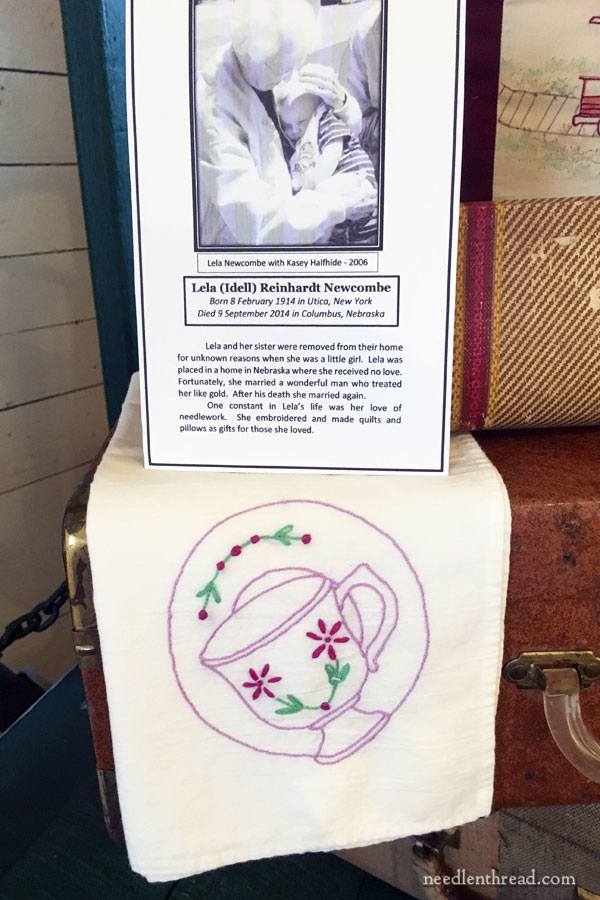
The Orphan Train riders’ stories are a mixture of sad and happy. At a time when immigrants were flooding into New York, the infrastructure simply wasn’t in place to help the large numbers of families who faced poverty and hardship in their new home. For better or for worse, the Orphan Trains were seen as a solution to alleviate the overwhelming problem of abandoned children on the streets of the city.
Two foundations, both with different approaches, sent children out on the trains.
The Children’s Aid Society sent them in groups, with adult representatives, to towns especially in the Midwest, where the agricultural and rural life was seen as ideal for the raising of children. The trains stopped in various towns along their routes, where notices had been placed in the newspapers announcing that children would be available for good homes. The children were placed on stages in the towns, and families were able to select a child or children from the group to take home.
The NY Foundlings Hospital, under the Sisters of Charity, operated in a different way, arranging adoptions ahead of time, so that the children were delivered via train directly to their new families.
You can well imagine the hardships these children faced, the fear and uncertainty that governed their lives, and the hope that they had for finding a good home. In many, many cases, that hope was realized. But in many cases, it was not, and not every story ended happily.
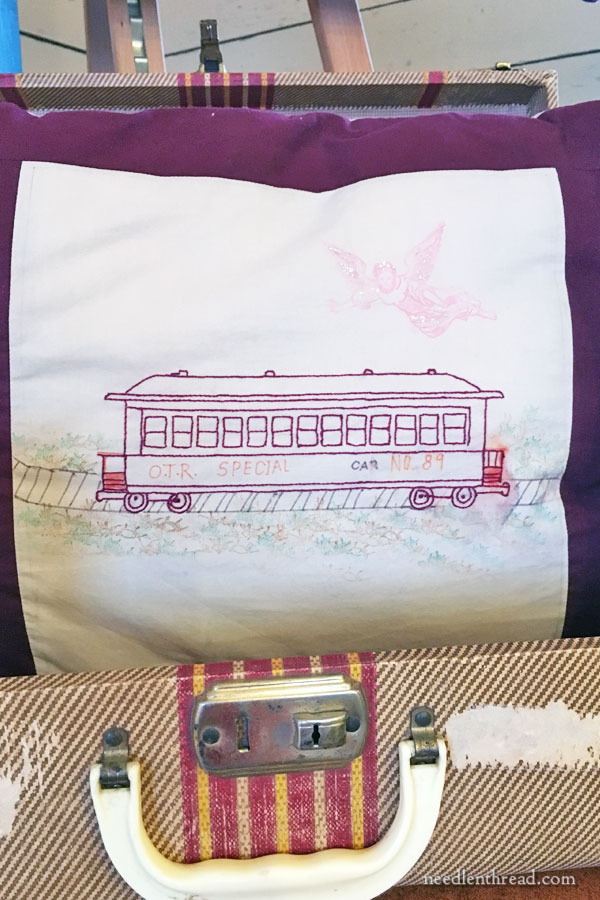
The embroiderer in me immediately homed in on some of the textiles in the museum. Redwork representations of the Orphan Train story can be seen on quilts and cushions here and there among the displays.
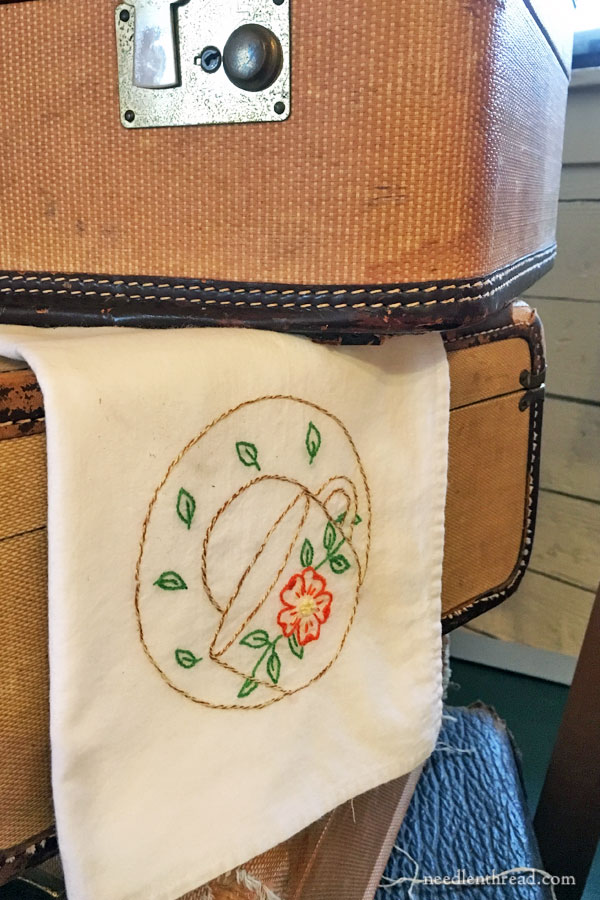
The embroidered flour sack towel, an American icon of sorts, makes several appearances among stacks of small suitcases.
Many of these were embroidered by Lela Reinhardt Newcombe, whose story is briefly told in the first photo above.
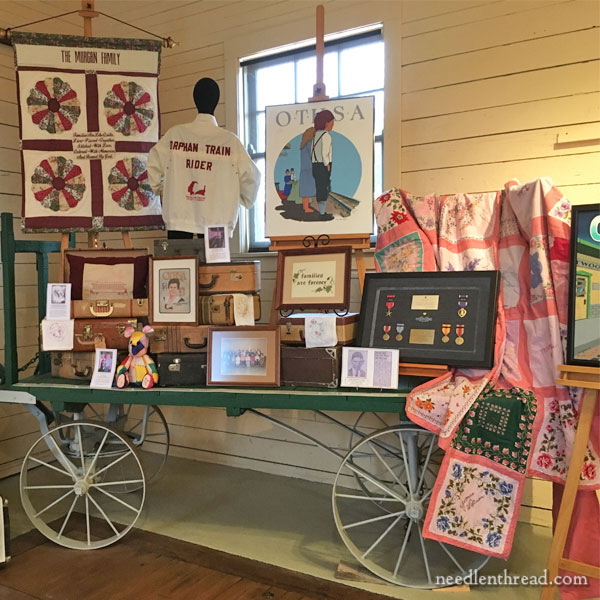
Quilts are always a part of the fabric of American frontier life, so it wasn’t unusual to see several displayed in the museum.
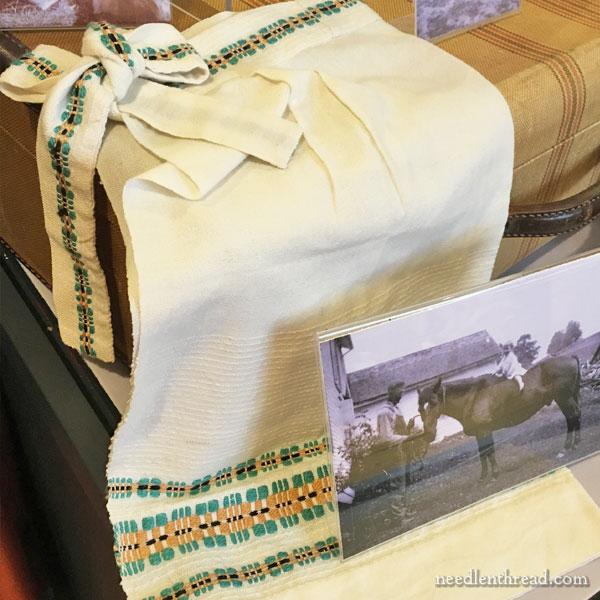
Aprons, too – hand embellished – make an appearance.
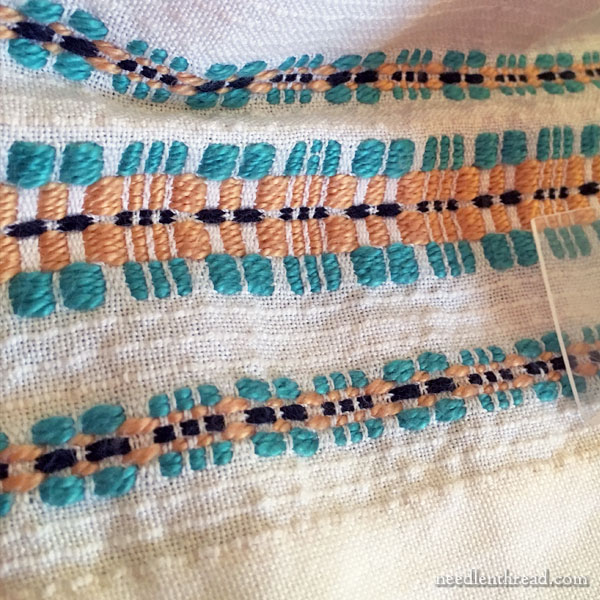
This particular apron is decorated with a series of running stitch patterns in a heavy cotton thread.
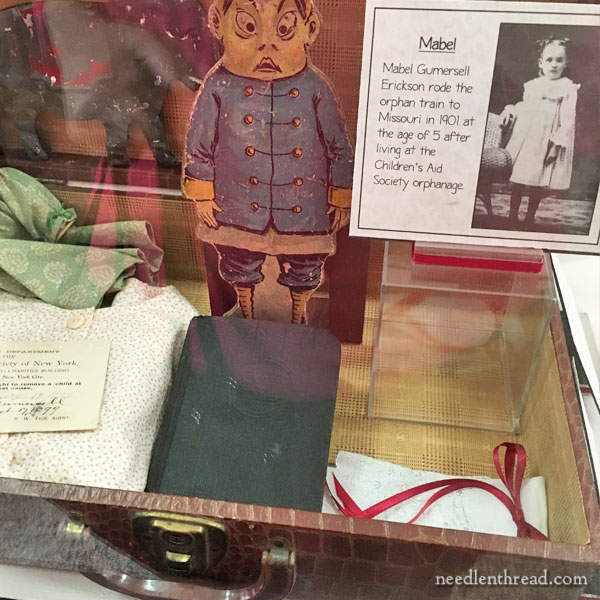
One of the sweetest little surprises in the museum was found in Mabel’s display case, where, tucked into her suitcase (with a rather scary paper doll) is a beautiful handkerchief in Appenzell whitework.
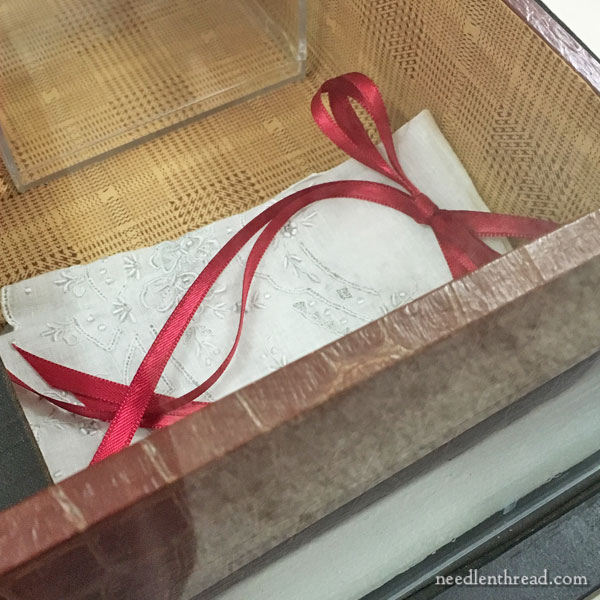
Since my friend and I were the only two visitors to the museum that morning when it opened, we were on the self-guided tour. I wasn’t able to discover whether this handkerchief was a display prop or if it was actually part of Mabel’s history.
I hope it was part of her history!
More About the Orphan Trains
If you want to read about the history of the Orphan Trains, the Orphan Train Museum website is a great place to start.
There are also plenty of books on the subject, if you search “orphan train movement” online.
And then there was Twine
Concordia is a three hour drive from my home, through rolling hills of verdant farm and pasture land. After being cooped up for some eight months, it was a glorious day out all around – really good for the soul!
I not only got to enjoy our beautiful countryside, but I was able to learn all about the Orphan Train Movement and a very interesting period of history that I knew little about before.
And, to top the day off and make it even more complete, we went to see this:
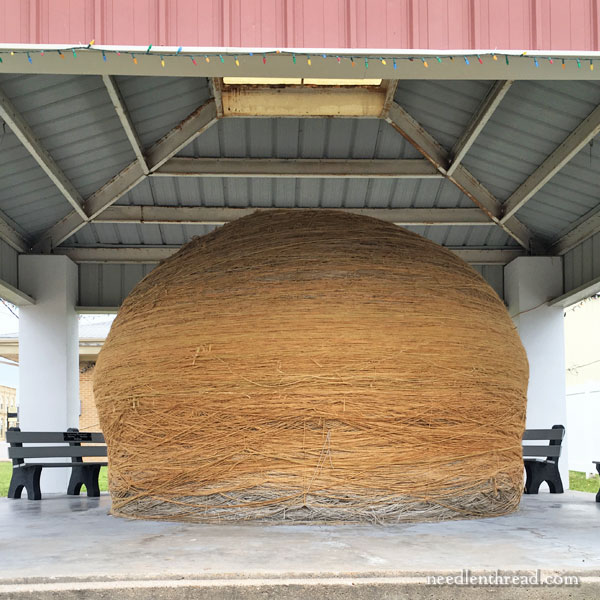
Yes. It is the world’s largest ball of twine. It was only forty-five minutes further down the road, and when you’re that close to such a Wonder, how can you resist?
It was simply… amazing.
To tell you the truth, I was more amazed that they have benches situated around it, so visitors can sit and contemplate.
Now that I’ve got the Ball of Twine crossed off the Bucket List it was never on, I feel like I can get on with life.
Hope you have a marvelous weekend!







Thank you for sharing these photos! I had no idea there was a museum dedicated to the children of the orphan trains. I am currently reading a novel whose main character is an alumna of the orphan trains: The Chaperone, by Laura Moriarty. It’s a good read, only tangentially about the trains and the “orphans” (not all actually were) whom they carried to new homes in the Midwest. Also about the beginning of the career of film actress Louise Brooks.
I just love daytrips and especially needle related daytrips. Will be heading to Concordia, Ks. this summer. Thank you.
Have you been to National Silk Art Museum in Weston, MO? Silk tapestries are beautiful.
And as long as you are in Weston, don’t forget Florilegium…eye candy for the eye, heart and mind.
I will put the National Silk Art Museum on my summer list, Sue! Thank you – I hadn’t even heard of it! I love going to Weston. It’s so beautiful, especially in the autumn. I’ve been to Florilegium, when it was in Parkville. Haven’t been yet since it moved to Weston (unless there are two of them now?!) So, a day trip to Weston. Hope to be up to it by next month!
Dear Mary
The drive to Concordia sounds lovely with the rolling hills and the farms and pasture land. I do love museums and the Orphan Train museum looks really interesting what a lovely day out for you. I never heard of the Orphan Train before did you discover what became of the orphans once they were placed with families that would be interesting. I love the embroidery especially the embroidered train and apron. The ball of twine is big to say the least, how did they get it to that size. I hope you have a great weekend.
Regards Anita Simmance
My heart goes out to those children and the varied lives they lived.
So glad you got to take a field trip. Truly good for the soul. I did not know there was a museum for the orphans. Some stories are very sad. Thank you for sharing both the museum and ball of thine. I might put that on my list.
As I admire the embroidery, I cannot help but wonder at the symbolism of the cup and saucer. Could it be the yearning of wanting to belong? Thanks for sharing.
BTW, just drove thru the beautiful, verdant Flint Hills of Kansas yesterday. The “Cattle Pens” exit always elicits a chuckle!
Thank you for allowing me to vicariously cross off the biggest ball of twine from my bucket list it was never on. I always enjoy your posts and look forward to them. Glad you were able to take a road trip. Best Wishes and prayers, Teresa
My husband’s great-grandfather was brought to the Midwest via the Orphan Train, though he wasn’t an orphan–he had a terribly abusive mom and stepdad and the nurses at the hospital sent him on the train basically to save his life.
Sadly, his is one of the sadder stories that demonstrates that the children weren’t always put into loving homes. He ended up changing his last name when he turned 18 (to the name of a man he admired from work, a boss I think) so that he could have a fresh start and cut ties with all of the abusive adults of his childhood.
Our library had a traveling exhibit a few years ago about the Orphan Trains and it was incredibly interesting, though not as in depth as the museum in Concordia! It’s a really interesting but also very sad thing.
Oh Mary,
What a wonderful adventure. I read a book about the Orphan Train and would love to visit the museum. It is now on my “bucket list”. Along with the ball of twine. . I love road trips like that!!!
Don’t expect too much from the ball of twine, Brenda! 🙂 Well, except that you can say you saw it, if that counts! I think it does – we’ve had a few good laughs over it in my family…!
Thanks for sharing that, Mary! Friends like that are a blessing, aren’t they? So glad you had a good trip and that you shared it with us. Take care.
I’m a weaver and I see all things through that lens. The apron looks more like a handwoven one – the pattern is Monk’s Belt. The colored yarn is laid in as the fabric is created on the loom. I’d love to visit that little museum to see it myself but your photo is very clear and I’m sure they wouldn’t let me touch it anyway!
Diane
Mary, thank you for the wonderful article. I think the orphan train might explain how my grandmother got from NYC to Laurel, DE. Must go on a further search for information. Thank you
Hi Mary! Thank you for the bit of history; I was unaware of the orphan trains. I wanted to give you some history on the ‘scary paper doll’. That is a Palmer Cox Brownie character, I am not certain which one. He was a children’s writer in the late 1800’s-early 1900’s. They were well merchandised as dolls, paper dolls and figurines.
That penultimate sentence kills me. 🙂 Keep on keeping on, Mary. You are a treasure, and if there were benches set up around you, I would gladly come and bask in your light.
I think the apron is woven with the design, not embroidered after weaving. It’s a type of patterning known as “Monk’s Belt” and can be done on a simple 4-shaft loom, the most common type in those households where weaving was still done back then. Monk’s Belt is associated with Scandinavian weaving, but was common all over Europe and probably beyond, because it is so easy to do with simple looms.
Holly
Thank you for this history lesson! I didn’t know about the Orphan Train. Now I do. It is always amazing how important textiles are in all these stories. Always! (Ball of Twine? not so much!!) Glad you are getting out and about a bit.
i have also been to see he twine, but since it was 30 yrs ago, it’s nice to see an update!
thank you for the interesting article as well
Hi. I wanted to comment that I had never heard of this until not long ago. A friend of mine, a quilter, said her husband had tried to trace his genealogy. He came to a dead end and was told that one of his ancestors had been one of the orphans on that train! He was a lucky one to be sure. I am sure not all stories had a happy ending but in his case he and his relatives were a part of the family! There was not any differences noted or told about in verbal messages past down thru the family. He was a member of the family, period.
He still considers himself as such but he knows that it was good people that loved him and gave his forebears a home and family …a forever family! There is no way to find out where he actually originated, but that really doesn’t matter, he is now and for generations has been part of his new family.
I just had to tell you because it is always good to pass on a happy story:)
I laughed out loud over the ball of twine! We will be traveling through Kansas soon and going by the deepest hand dug well. I may make my family pay the fee so I can cross it off my bucket list!
I can’t believe this wonderful blend of fabrics and orphan train!!!! I speak about the orphan train to groups all the time and have written a book based on it. Most importantly, I have spoken on the Dust Bowl, and the whole feed/sugar sack fabric era is part of my speaking as well as two quilts from that era. I am speechless at your article because it brings my passion for fibers to a higher level. Thanks. My book is A Mother’s Song, and is widely read on the South Side Irish side of Chicago as Irish history.
We visited the Largest Ball of Twine hand rolled by one person…in Darwin, MN. We thoroughly enjoyed it…and the Spam Museum.
We are weird people.
I always say that no matter where you are there are things to see. That museum sounds like a must and yes, who can miss that ball of twine?
Mary, this sounds like a place i would love,and your post has sparked a little bit of a quest to fill in the gaps so to speak. I was unaware of this piece of frontier history in the U.S.
I hope your health is in an upward swing…believe it or not, i worry about you(of course i know that it’s silly, and probably not necessary, what with all your family and friends, but all the same….).
Lovely to read that you a had a fab. day out.
Mary, let me know when you are going to Weston; I’d love to meet you. Would be happy to join you at Florilegium and visit the museum again…You will not believe the new Florilegium, I think it is better than when in Parkville. Eye candy abounds and the air is full of creativity.
Hi Mary, funny you wrote about the Orphan Train Museum. I just passed the sign on my way home to Lawrence and said out loud to the hubs, we need to go there sometime!!! A silk museum in Weston!!! That’s a must go!
Hey Mary:
glad to hear you had a great day! I have never heard of the orphan trains. what a dichotomy of emotions struck me. sadness and gladness combined. keep on keepin on Mary! it’s the only way to fly through life, I think.
Thanks for telling us about your little trip! I’ve learned about the orphan trains before, but I had never heard of that museum. It sounds like it would be very interesting; I’d like to visit it someday if I just happen to be in or around Kansas.
That twine ball though… lol 🙂
Heart wrenching to read about the orphan trains. So good to know that their trials haven’t been forgotten and that there is a museum in their memory. Interesting ball of twine – wonder what the story is behind it even being made.